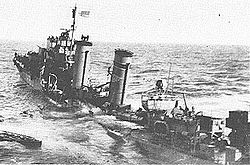HMS Brazen (H80)
|
The sinking brazen
|
||||||||||||||||||||||
|
||||||||||||||||||||||
|
||||||||||||||||||||||
|
||||||||||||||||||||||
|
||||||||||||||||||||||
HMS Brazen (H80) was a destroyer of the B-Class , the British in April 1931 in the service of the Royal Navy came. During the Second World War , the destroyer was awarded the two Battle Honors "Norway 1940" and "English Channel 1940".
While securing a coastal convoy, the Brazen was sunk on July 20, 1940 by German dive bombers in the Strait of Dover off Folkestone .
History of the ship
As part of the Royal Navy's second class destroyer, which was built after the end of the First World War , the Brazen and her sister ship Boreas were ordered from the Palmers shipyard in Jarrow on the Tyne on March 22, 1929 . The orders for the six other destroyers and the almost identical B-class flotilla leader Keith went to four other shipyards. Four ships were also built on the Tyne near Hawthorn Leslie in Hebburn and Swan Hunter in Wallsend . The keel laying of the two destroyers Boreas and Brazen took place at Palmers on July 22, 1929 under construction numbers 996 and 997. The Brazen was launched a week after the Boreas on July 25, 1930. The destroyer was then taken over by the Royal Navy on April 8, 1931, eight weeks after its sister ship. The new destroyer was the sixth ship in the Royal Navy, named Brazen . A 30-knot destroyer had last used the name in the Navy from 1900 to 1919. The old Brazen , built in Clydebank , had been assigned to the C-Class since 1912 and was used for coastal protection in the Thames estuary during the First World War .
Mission history
The Brazen and the other ships of the new class put into service between February and June 1931 replace older V and W class destroyers in the “4th Destroyer Flotilla” on the Mediterranean Fleet . In 1936 the flotilla with the B-class destroyer was moved to the Home Fleet . Because of the increasing political tensions, individual ships of the flotilla also temporarily moved to Gibraltar and took part in the so-called neutrality patrols off the Spanish coasts because of the Spanish Civil War . At the beginning of 1939, however, the Brazen, like other units of the class, became part of the reserve fleet because a large number of more modern destroyers had been put into service in the meantime. In June 1939, the re-activated ship took part in attempts to rescue the British submarine Thetis , which had sunk off Liverpool .
War missions
At the beginning of the war the destroyer was reactivated and was assigned to the 19th Destroyer Flotilla. His duties included securing convoys and warships in the waters around the British Isles and patrols in the Dover Strait . In 1940 the Brazen was mostly used in the North Sea to secure east coast convoys and mine-laying operations. In April 1940, the destroyer was then used in the attempted defense against the German landing in Norway ( Operation Weser Exercise ) to cover ships of the Home Fleet. He was able to sink U 49 with depth charges in front of the Vågsfjord on April 15, together with the destroyer Fearless . The two destroyers rescued 41 men from the submarine crew and found some documents and a naval square map in objects that were found. Mainly the destroyer was used during the Norway missions to secure the supply escorts.
The end of the brazen
At the end of May 1940, the Brazen moved to the southern North Sea. On the march to Harwich occurred in the wash to a grounding. The repair of the damage prevented the Brazen from participating in the evacuation of the Allied troops encircled around Dunkirk ( Operation Dynamo ). After the five-week repairs, the destroyer was transferred to the 1st Destroyer Flotilla in Portsmouth . His main task now was to secure small escorts in the English Channel . In the first phase of the Battle of Britain , the attacks by the German Air Force were mainly directed against these coast escorts. Brazen reinforced convoy CW.7 with a submarine trawler in the canal, which had already been secured by the destroyers Boreas , Versatile and Windsor when on July 21, 1940 Ju 87 Stukas of Group II / Sturzkampfgeschwader 1 attacked off Dover . The Brazen was badly damaged by a close hit and was unable to maneuver. Boreas took over the crew of the sister ship. An arriving tug hooked the incapacitated destroyer. He declined drag for a direct bomb hits at 51 ° 1 ' N , 1 ° 17' O . Only one crew member was killed in the air raids on the ship and in its sinking.
literature
- Norman Friedman: British Destroyers From Earliest Days to the Second World War. Naval Institute Press, Annapolis MD 2009, ISBN 978-1-59114-081-8 .
- Michael J. Whitley: Destroyers of World War Two. An international encyclopedia. Arms and Armor Press, London a. a. 1988, ISBN 0-85368-910-5 .
Web links
- HMS Brazen (H 80) - B-class Destroyer
- Brazen 1931
- HMS Brazen (H 80)
- Chronicle of naval warfare 1939–1945
- HMS Brazen wrecksite
Individual notes
- ↑ a b Service History HMS Brazen
- ↑ Rohwer: naval warfare , 07/04/1940 North Sea / Norway + 13.-04.15.1940 Norway
- ^ Rohwer: Maritime War , July 9-30, 1940 Canal
